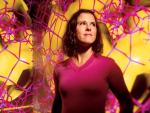Nanosize does matter
Your life is about to change - and you won't see it coming. New technology promises to make a big impact on nearly every aspect of our lives - from sophisticated "smart" drugs to healthier food - but on the tiniest level imaginable. The field is nanotechnology: working with some of the smallest matter known, molecules, to do some amazing things. The University of Adelaide is at the forefront of education and research in nanotechnology. For her PhD, Chemistry student Julia Lock conducted groundbreaking research, developing a special kind of "molecular switch".
These switches are very small - approximately 0.000000001m in size - which means she can't see what she's receiving her PhD for. Literally. "Nanotechnology can be described as a new approach to miniaturising our technologies," Julia said. "Instead of trying to make increasingly smaller versions of current technologies, the idea is to work 'from the bottom up' and begin with the smallest components available to us: molecules." The type of switch Julia has been working on can be activated by heat or light, and has enormous implications for many industries, including those of medicine, pharmaceuticals and food. For example, researchers could use Julia's technology to develop drugs which are sent into targeted areas of the human body and, when activated by light, switch "on". Another potential use could be protecting certain additives in food, which would then increase the food's storage life. One of the most important parts of Julia's research was to make her molecular switches "self-assemble". "Obviously, because the molecules are so small, it was impossible for me for to assemble the switches myself," she said. For her molecular switch, Julia had to get a relatively small and straight-shaped molecule known as a stilbene to sit inside a tube-shaped molecule known as a cyclodextrin. Two cyclodextrin molecules - joined together by a "linker" molecule - are used to host one stilbene. This is done by using water as a solvent: both the stilbene and the inside of the cyclodextrin are "water-hating", so the stilbene "seeks refuge" or becomes the "guest" inside the "host" of the larger cyclodextrin. Having assembled itself, the new molecule can now be switched "on" with a burst of UV light. "Switching the new molecule on causes a change in the shape of the stilbene molecule - it goes from being relatively straight to a bent shape, almost a V-shape," Julia said. "So instead of fitting snugly inside its host, now half of it is hanging outside of one end of one of the cyclodextrins. This is important, because the other end of the cyclodextrin is now free and could be used as a host for a second guest molecule." Having just finished her PhD, Julia has now started a post-doctoral fellowship at the University of Edinburgh in Scotland to further her research into nanotechnology. Julia has also been chosen as one of the new faces in the University of Adelaide's Life Impact campaign. Story by Ben Osborne
|




